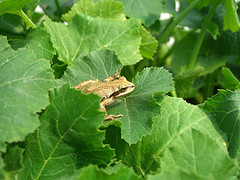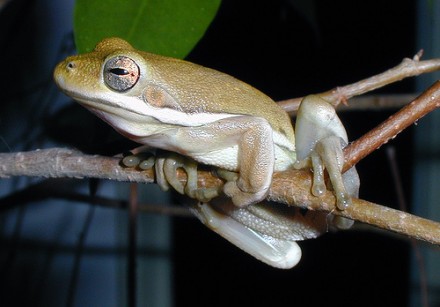Tree frogs are a member of the Bufonidae family which comprises of approximately 300 different species. Tree frogs eat mostly a variety of insects, such as flies, moths, worms, grasshoppers and crickets. Traditionally (and as the name suggests), tree frogs tend to spend most of their lifetime in trees or other high growing vegetation. Green tree frogs however, are common house pets in their native Australia.
They live a long time, in some cases over 25 years and are easy to maintain and seem to have adapted well to life in confined spaces. They will also tolerate a small amount of handling, which makes them desirable children’s pets. In the wild most frogs eat only insects, and this should not change if you are keeping them as pets. The most common dietary problems in frogs are related to a lack of calcium or too much protein in the diet.
You can buy calcium powders from selected pet shops which should be combined with a multivitamin powder before dusting on food prior to feeding your frog. The best way to do this is like you would with a roasting bag. Put the insects in the bag, add a pinch of the calcium/multivitamin powder and shake it up so the insects are fully coated.
It is important to not mix large quantities of this powder at a time as the calcium will denature the vitamins. In terms of high protein diets such as young mice or strips of meat, it is advisable to steer well clear as foods like these will put a strain on the frog’s organs, particularly the kidneys, and if fed regularly could lead to gout, irreversible kidney disease and ultimately death.
They live a long time, in some cases over 25 years and are easy to maintain and seem to have adapted well to life in confined spaces. They will also tolerate a small amount of handling, which makes them desirable children’s pets. In the wild most frogs eat only insects, and this should not change if you are keeping them as pets. The most common dietary problems in frogs are related to a lack of calcium or too much protein in the diet.
You can buy calcium powders from selected pet shops which should be combined with a multivitamin powder before dusting on food prior to feeding your frog. The best way to do this is like you would with a roasting bag. Put the insects in the bag, add a pinch of the calcium/multivitamin powder and shake it up so the insects are fully coated.
It is important to not mix large quantities of this powder at a time as the calcium will denature the vitamins. In terms of high protein diets such as young mice or strips of meat, it is advisable to steer well clear as foods like these will put a strain on the frog’s organs, particularly the kidneys, and if fed regularly could lead to gout, irreversible kidney disease and ultimately death.


